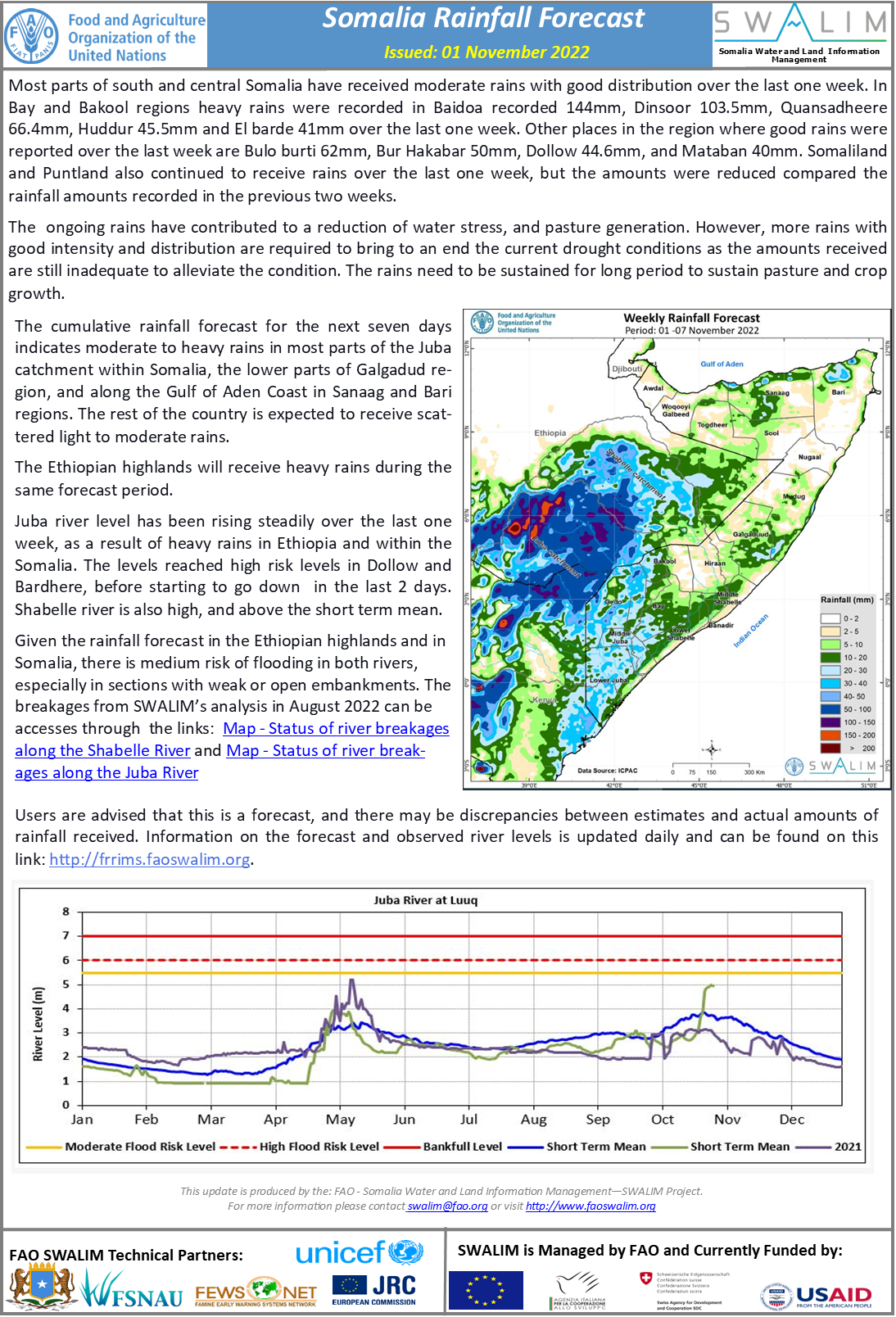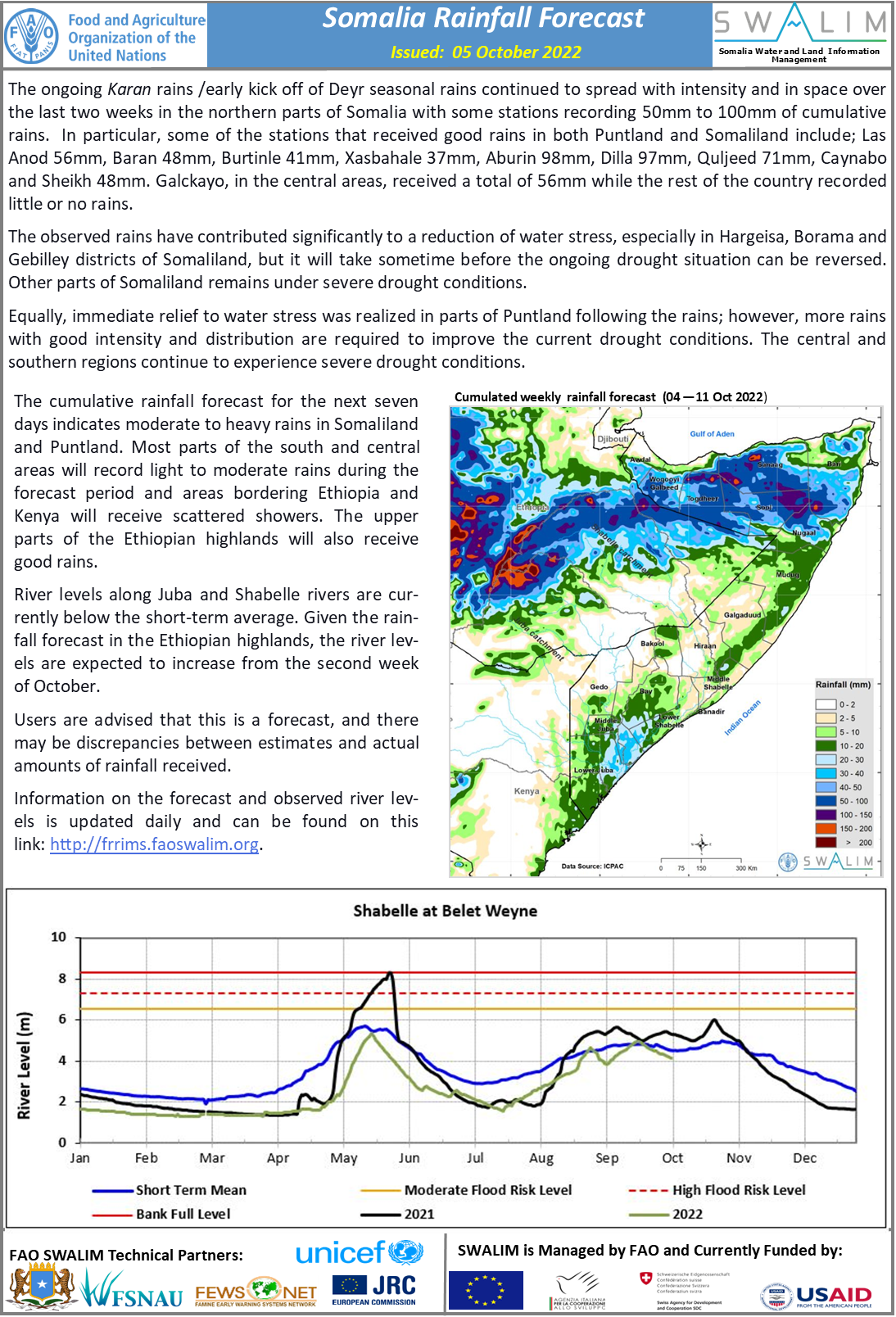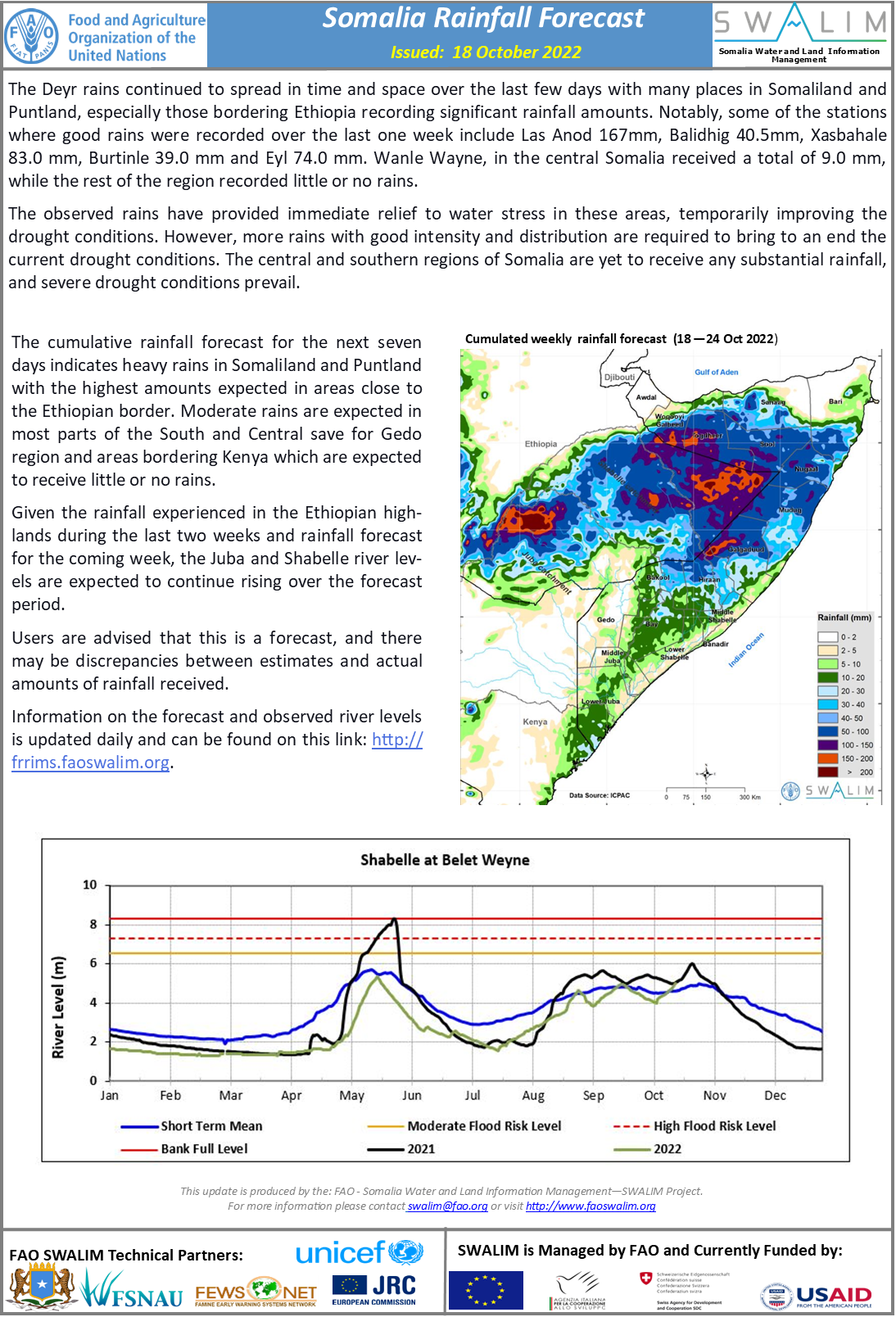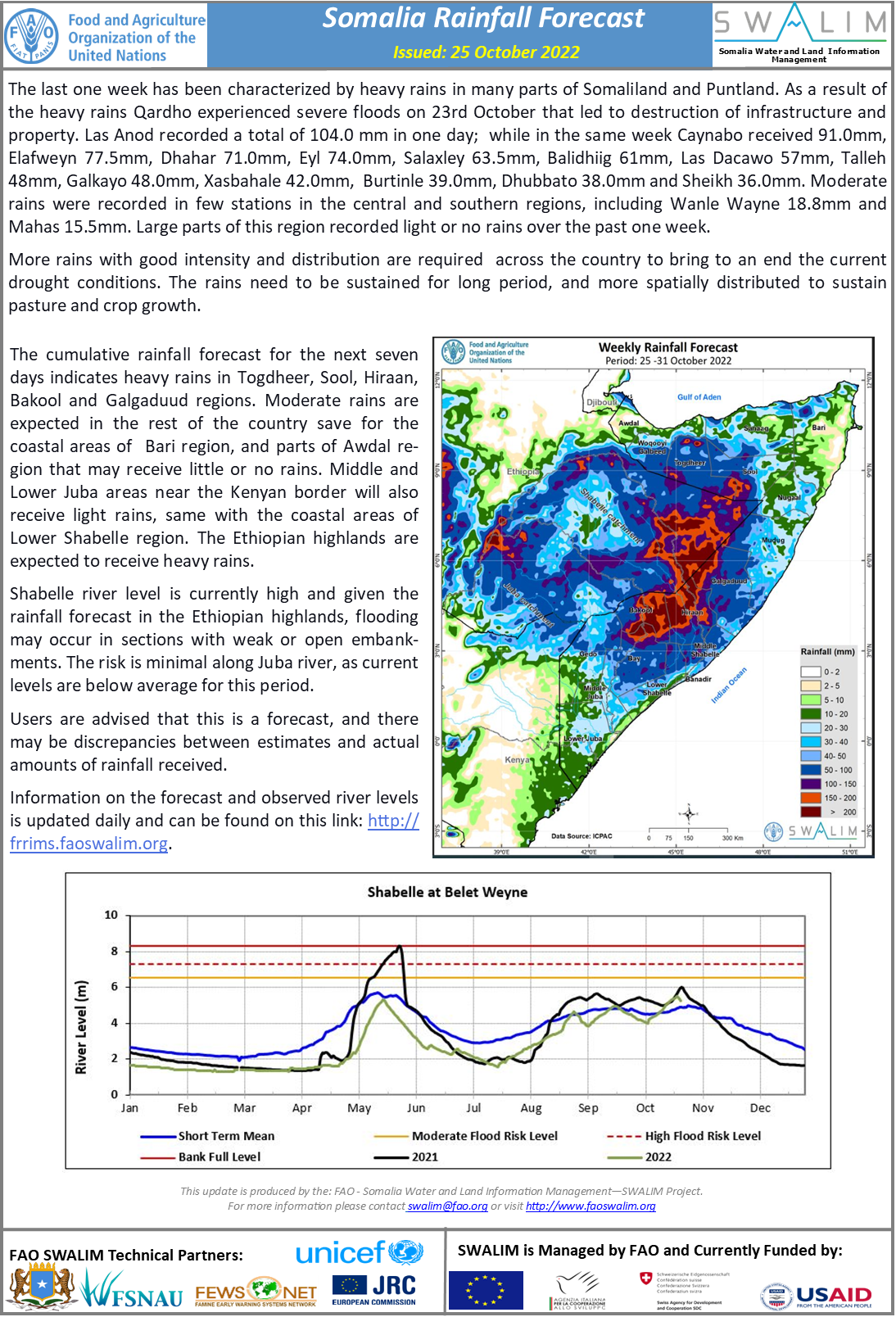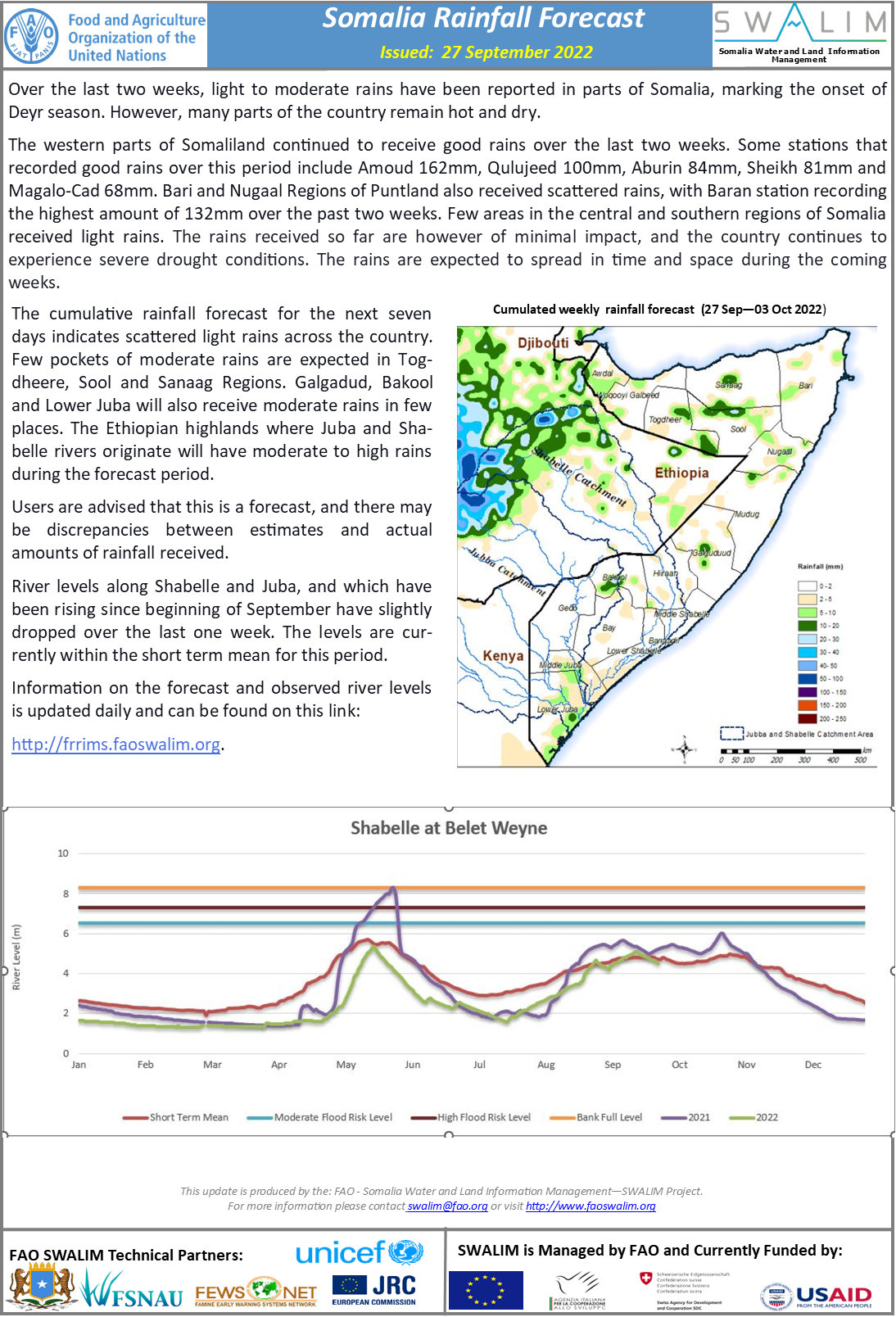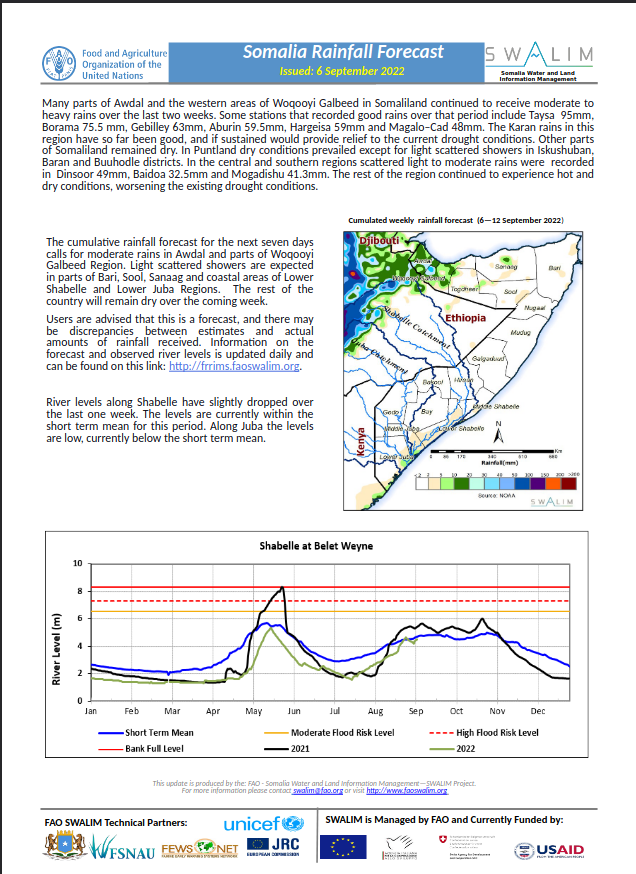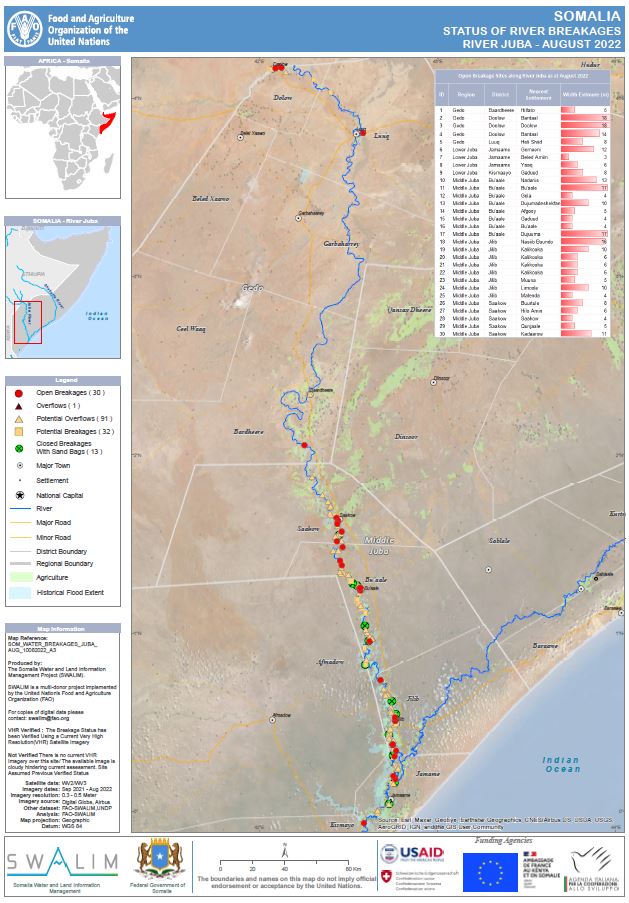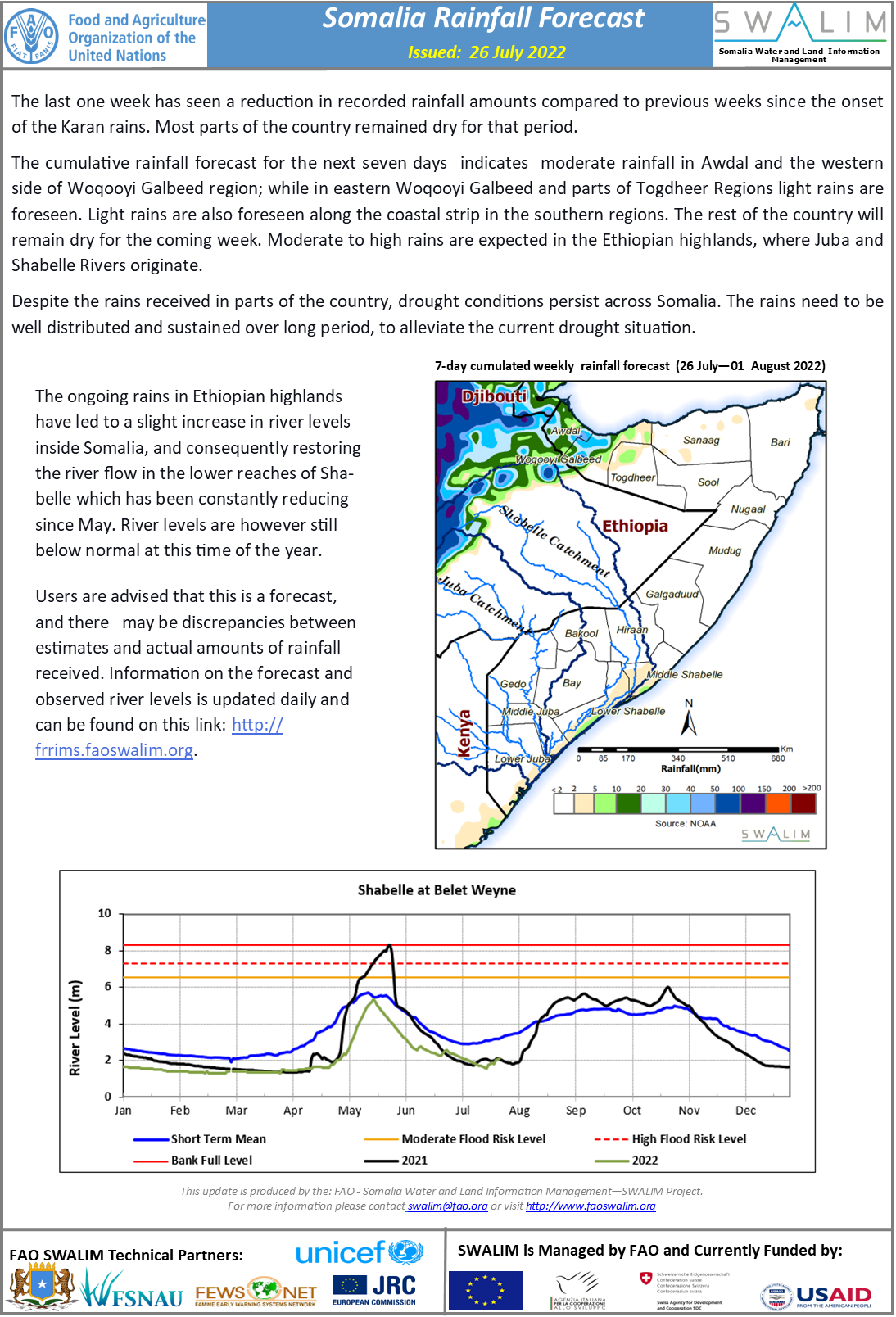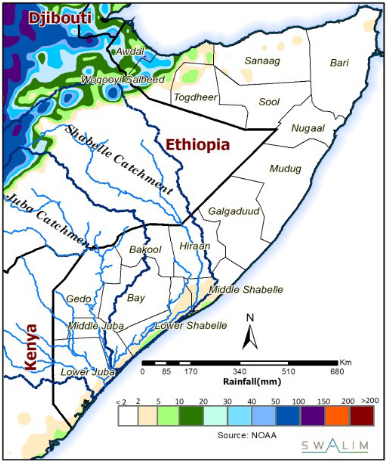Library Catalog
Latest Documents and Publications listed. Use search terms in the box below to find what you need
Somalia Rainfall Forecast – Issued 01 November 2022
Most parts of south and central Somalia have received moderate rains with good distribution over the last one week. In Bay and Bakool regions heavy rains were recorded in Baidoa recorded 144mm, Dinsoor 103.5mm, Quansadheere 66.4mm, Huddur 45.5mm and El barde 41mm over the last one week. Other places in the region where good rains were reported over the last week are Bulo burti 62mm, Bur Hakabar 50mm, Dollow 44.6mm, and Mataban 40mm. Somaliland and Puntland also continued to receive rains over the last one week, but the amounts were reduced compared the rainfall amounts recorded in the previous two weeks.
The ongoing rains have contributed to a reduction of water stress, and pasture generation. However, more rains with good intensity and distribution are required to bring to an end the current drought conditions as the amounts received are still inadequate to alleviate the condition. The rains need to be sustained for long period to sustain pasture and crop growth.
The cumulative rainfall forecast for the next seven days indicates moderate to heavy rains in most parts of the Juba catchment within Somalia, the lower parts of Galgadud region, and along the Gulf of Aden Coast in Sanaag and Bari regions. The rest of the country is expected to receive scattered light to moderate rains.
The Ethiopian highlands will receive heavy rains during the same forecast period.
Juba river level has been rising steadily over the last one week, as a result of heavy rains in Ethiopia and within the Somalia. The levels reached high risk levels in Dollow and Bardhere, before starting to go down in the last 2 days. Shabelle river is also high, and above the short term mean.
Given the rainfall forecast in the Ethiopian highlands and in Somalia, there is medium risk of flooding in both rivers, especially in sections with weak or open embankments.
Publication Type:
Rainfall Forecast
Publication Date:
Author:
Corporate Author:
Somalia Rainfall Forecast – Issued 05 October 2022
The ongoing Karan rains /early kick off of Deyr seasonal rains continued to spread with intensity and in space over the last two weeks in the northern parts of Somalia with some stations recording 50mm to 100mm of cumulative rains. In particular, some of the stations that received good rains in both Puntland and Somaliland include; Las Anod 56mm, Baran 48mm, Burtinle 41mm, Xasbahale 37mm, Aburin 98mm, Dilla 97mm, Quljeed 71mm, Caynabo and Sheikh 48mm. Galckayo, in the central areas, received a total of 56mm while the rest of the country recorded little or no rains.
The observed rains have contributed significantly to a reduction of water stress, especially in Hargeisa, Borama and Gebilley districts of Somaliland, but it will take sometime before the ongoing drought situation can be reversed. Other parts of Somaliland remains under severe drought conditions.
Equally, immediate relief to water stress was realized in parts of Puntland following the rains; however, more rains with good intensity and distribution are required to improve the current drought conditions. The central and southern regions continue to experience severe drought conditions.
The cumulative rainfall forecast for the next seven days indicates moderate to heavy rains in Somaliland and Puntland. Most parts of the south and central areas will record light to moderate rains during the forecast period and areas bordering Ethiopia and Kenya will receive scattered showers. The upper parts of the Ethiopian highlands will also receive good rains.
River levels along Juba and Shabelle rivers are currently below the short-term average. Given the rainfall forecast in the Ethiopian highlands, the river levels are expected to increase from the second week of October.
Users are advised that this is a forecast, and there may be discrepancies between estimates and actual amounts of rainfall received.
Information on the forecast and observed river levels is updated daily and can be found on this link: http://frrims.faoswalim.org.
Publication Type:
Rainfall Outlook
Publication Date:
Author:
Corporate Author:
Somalia Rainfall Forecast – Issued 18 October 2022
The Deyr rains continued to spread in time and space over the last few days with many places in Somaliland and Puntland, especially those bordering Ethiopia recording significant rainfall amounts. Notably, some of the stations where good rains were recorded over the last one week include Las Anod 167mm, Balidhig 40.5mm, Xasbahale 83.0 mm, Burtinle 39.0 mm and Eyl 74.0 mm. Wanle Wayne, in the central Somalia received a total of 9.0 mm, while the rest of the region recorded little or no rains.
The observed rains have provided immediate relief to water stress in these areas, temporarily improving the drought conditions. However, more rains with good intensity and distribution are required to bring to an end the current drought conditions. The central and southern regions of Somalia are yet to receive any substantial rainfall, and severe drought conditions prevail.
The cumulative rainfall forecast for the next seven days indicates heavy rains in Somaliland and Puntland with the highest amounts expected in areas close to the Ethiopian border. Moderate rains are expected in most parts of the South and Central save for Gedo region and areas bordering Kenya which are expected to receive little or no rains.
Given the rainfall experienced in the Ethiopian highlands during the last two weeks and rainfall forecast for the coming week, the Juba and Shabelle river levels are expected to continue rising over the forecast period.
Publication Type:
Rainfall Forecast
Publication Date:
Author:
Corporate Author:
Somalia Rainfall Forecast – Issued 25 October 2022
The last one week has been characterized by heavy rains in many parts of Somaliland and Puntland. As a result of the heavy rains Qardho experienced severe floods on 23rd October that led to destruction of infrastructure and property. Las Anod recorded a total of 104.0 mm in one day; while in the same week Caynabo received 91.0mm, Elafweyn 77.5mm, Dhahar 71.0mm, Eyl 74.0mm, Salaxley 63.5mm, Balidhiig 61mm, Las Dacawo 57mm, Talleh 48mm, Galkayo 48.0mm, Xasbahale 42.0mm, Burtinle 39.0mm, Dhubbato 38.0mm and Sheikh 36.0mm. Moderate rains were recorded in few stations in the central and southern regions, including Wanle Wayne 18.8mm and Mahas 15.5mm. Large parts of this region recorded light or no rains over the past one week.
More rains with good intensity and distribution are required across the country to bring to an end the current drought conditions. The rains need to be sustained for long period, and more spatially distributed to sustain pasture and crop growth.
The cumulative rainfall forecast for the next seven days indicates heavy rains in Togdheer, Sool, Hiraan, Bakool and Galgaduud regions. Moderate rains are expected in the rest of the country save for the coastal areas of Bari region, and parts of Awdal region that may receive little or no rains. Middle and Lower Juba areas near the Kenyan border will also receive light rains, same with the coastal areas of Lower Shabelle region. The Ethiopian highlands are expected to receive heavy rains.
Shabelle river level is currently high and given the rainfall forecast in the Ethiopian highlands, flooding may occur in sections with weak or open embankments. The risk is minimal along Juba river, as current levels are below average for this period.
Publication Type:
Rainfall Forecast
Publication Date:
Author:
Corporate Author:
Somalia Rainfall Forecast – Issued 27 September 2022
Over the last two weeks, light to moderate rains have been reported in parts of Somalia, marking the onset of Deyr season. However, many parts of the country remain hot and dry.
The western parts of Somaliland continued to receive good rains over the last two weeks. Some stations that recorded good rains over this period include Amoud 162mm, Qulujeed 100mm, Aburin 84mm, Sheikh 81mm and Magalo-Cad 68mm. Bari and Nugaal Regions of Puntland also received scattered rains, with Baran station recording the highest amount of 132mm over the past two weeks. Few areas in the central and southern regions of Somalia received light rains. The rains received so far are however of minimal impact, and the country continues to experience severe drought conditions. The rains are expected to spread in time and space during the coming weeks.
The cumulative rainfall forecast for the next seven days indicates scattered light rains across the country. Few pockets of moderate rains are expected in Togdheere, Sool and Sanaag Regions. Galgadud, Bakool and Lower Juba will also receive moderate rains in few places. The Ethiopian highlands where Juba and Shabelle rivers originate will have moderate to high rains during the forecast period.
River levels along Shabelle and Juba, and which have been rising since beginning of September have slightly dropped over the last one week. The levels are currently within the short term mean for this period.
Publication Type:
Rainfall Forecast
Publication Date:
Author:
Corporate Author:
Somalia Rainfall Forecast – Issued 06 September 2022
Many parts of Awdal and the western areas of Woqooyi Galbeed in Somaliland continued to receive moderate to heavy rains over the last two weeks. Some stations that recorded good rains over that period include Taysa 95mm, Borama 75.5 mm, Gebilley 63mm, Aburin 59.5mm, Hargeisa 59mm and Magalo–Cad 48mm.
The Karan rains in this region have so far been good, and if sustained would provide relief to the current drought conditions. Other parts of Somaliland remained dry. In Puntland dry conditions prevailed except for light scattered showers in Iskushuban, Baran and Buuhodle districts. In the central and southern regions scattered light to moderate rains were recorded in Dinsoor 49mm, Baidoa 32.5mm and Mogadishu 41.3mm. The rest of the region continued to experience hot and dry conditions, worsening the existing drought conditions.
Publication Type:
Rainfall Forecast
Publication Date:
Author:
Corporate Author:
Somalia Drought Update – Issued 12 August 2022
Drought conditions improved slightly in the southern coastal areas and Awdal region in July following moderate Karan rains. Although the rains were not well distributed, they improved the vegetation conditions, which may be short-lived due to an influx of livestock into these areas.
The other areas were dominated by dry and hot weather conditions, worsening drought severity in many parts of Somalia, leaving 90% of the country under extreme drought conditions.
The groundwater levels across the country are going down, at alarming rates in some regions, from over pumping due to increased pressure to meet demand.
Water trucking for domestic and animal use has been intensified.
The Juba and Shabelle River levels are below the short-term average, with little water available to support irrigation of crops and other uses.
Publication Type:
Drought watch
Publication Date:
Author:
Corporate Author:
Status of River Breakages along Juba and Shabelle Rivers, August 2022
Four consecutive poor rainy seasons in most parts of the Horn of Africa region have resulted to current serious hydrological drought conditions in Somalia and neighboring countries.. Juba and Shabelle Rivers, with the headwaters in the Ethiopian highlands have remained below the long term average since the beginning of 2022, negatively impacting agriculture production, domestic and livestock water use for the riverine communities. The low river levels however provide an opportunity to fix the river breakages and weak embankments, ahead of the next rainy season.
SWALIM has updated the status of the river breakages along the Juba and Shabelle Rivers using available Very High Resolution (VHR) satellite imagery and a Digital Elevation Model (DEM).
Five types of breakages have been identified, namely; open, overflow, potential overflows, potential breakages and closed with sandbags. The open breakages are those that are currently open as observed on the latest VHR image available. All the observations reported refers to the latest suitable VHR satellite image available, which is indicated in the online database.
100 Open breakage points have been identified, 70 on the Shabelle River and 30 on the Juba River which require immediate action. 13 Overflows were also identified during this season. Jowhar district was worst affected along the Shabelle while Bu’aale and Jilib districts are worst affected along the Juba.
Users are advised that the methodology is biased towards Remote Sensing (RS) interpretation with only limited “ground truthing” due to access constraints. Open breakages might have been omitted in some cases where satellite images may not have been very clear (e.g. heavy cloud cover) or were not available.
Publication Type:
Map
Publication Date:
Author:
Corporate Author:
Somalia Rainfall Forecast – Issued 26 July 2022
The last one week has seen a reduction in recorded rainfall amounts compared to previous weeks since the onset of the Karan rains. Most parts of the country remained dry for that period.
The cumulative rainfall forecast for the next seven days indicates moderate rainfall in Awdal and the western side of Woqooyi Galbeed region; while in eastern Woqooyi Galbeed and parts of Togdheer Regions light rains are foreseen. Light rains are also foreseen along the coastal strip in the southern regions. The rest of the country will remain dry for the coming week. Moderate to high rains are expected in the Ethiopian highlands, where Juba and Shabelle Rivers originate.
Despite the rains received in parts of the country, drought conditions persist across Somalia. The rains need to be well distributed and sustained over long period, to alleviate the current drought situation.
The ongoing rains in Ethiopian highlands have led to a slight increase in river levels inside Somalia, and consequently restoring the river flow in the lower reaches of Shabelle which has been constantly reducing since May. River levels are however still below normal at this time of the year.
Publication Type:
Rainfall Forecast
Publication Date:
Author:
Corporate Author:
Somalia Rainfall Forecast – Issued 26 July 2022
The last one week has seen a reduction in recorded rainfall amounts compared to previous weeks since the onset of the Karan rains. Most parts of the country remained dry for that period.
The cumulative rainfall forecast for the next seven days indicates moderate rainfall in Awdal and the western side of Woqooyi Galbeed; while in eastern Woqooyi Galbeed and parts of Togdheer Regions light rains are foreseen.
Light rains are also foreseen along the coastal strip in the southern regions. The rest of the country will remain dry for the coming week. Moderate to high rains are expected in the Ethiopian highlands, where Juba and Shabelle Rivers originate.
Despite the rains received in parts of the country, drought conditions persist due across Somalia. The rains need to be well distributed and sustained over a long period, to alleviate the current drought situation.
Publication Type:
Rainfall Forecast
Publication Date:
Author:
Corporate Author:
Pages
 RSS feed [compliant with the Agris AP] |
RSS feed [compliant with the Agris AP] |  Agris AP XML
Agris AP XML


